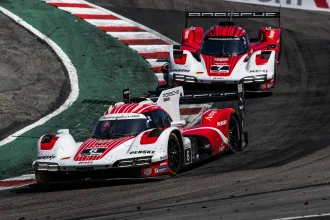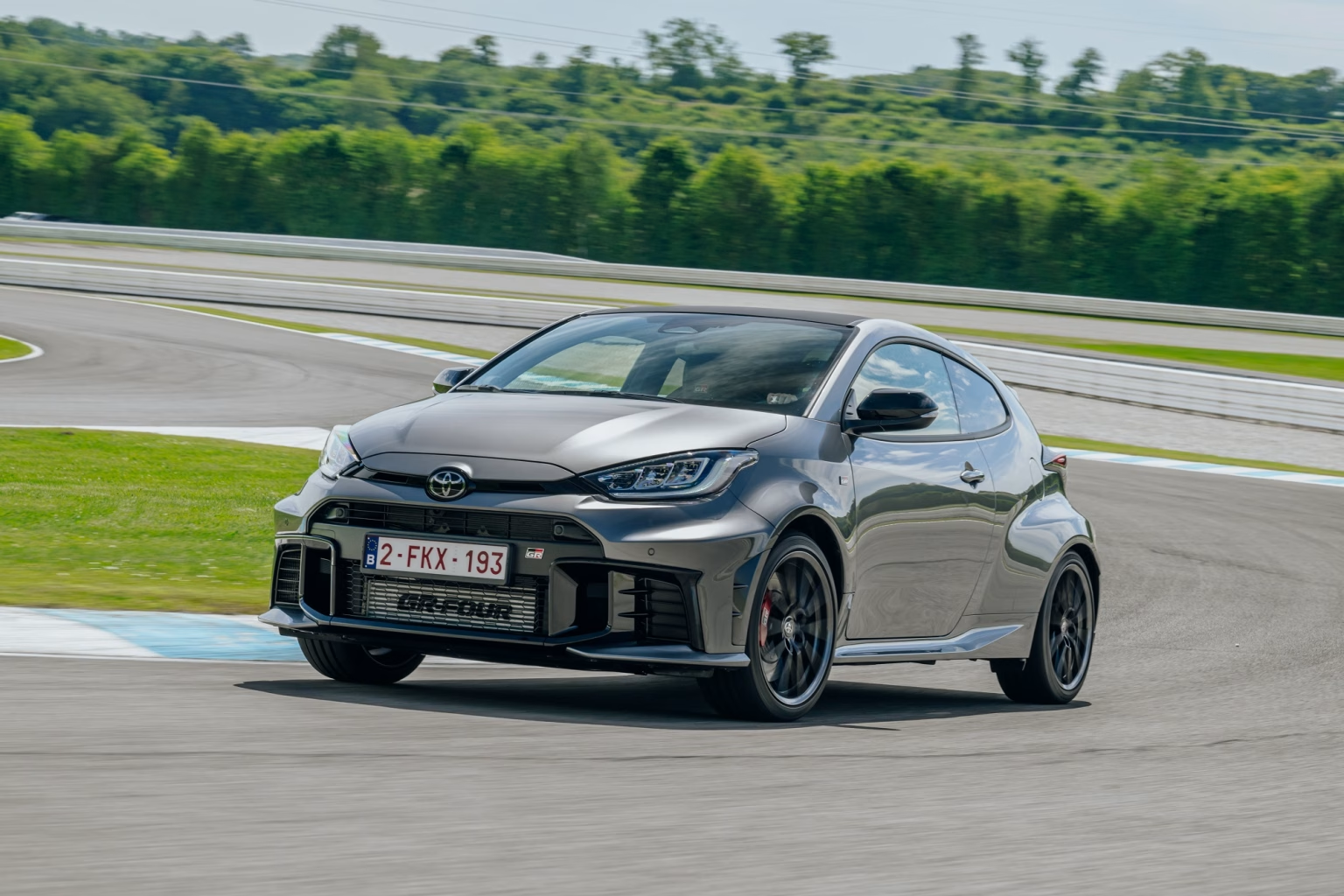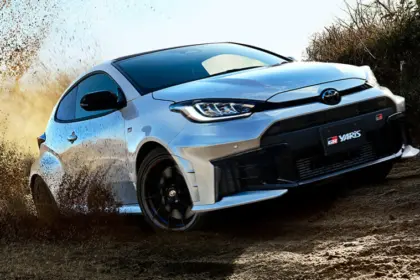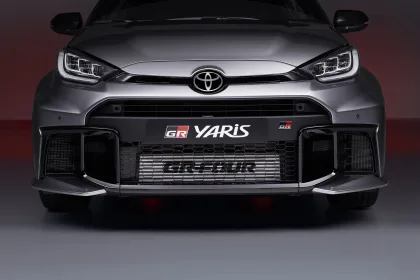- Significant updates for Toyota’s rally-bred performance hatchback
- Maximum power from the in-line three-cylinder 1.6-litre turbocharged engine increased to 280 DIN hp/206 kW, with peak torque of 390 Nm
- Brand new eight-speed GAZOO Racing Direct Automatic Transmission option with competition-standard rapid shifting
- Redesigned driver’s cockpit with race car-style digital instrumentation and improved location of key controls and data sources
- Increased body rigidity, strengthened suspension, full-time all-wheel drive and new selectable drive modes
- Single “Circuit” specification version offered in Europe, with powertrain cooling package as standard
- Exclusive Ogier and Rovanperä special editions, developed by TOYOTA GAZOO Racing’s world champion drivers
- Conversion of the GR Yaris to run on hydrogen gives a glimpse of future possibilities for developing performance car engines that use carbon-neutral fuel
The new Toyota GR Yaris benefits from technical, design and construction enhancements that promise to deliver an even greater driving experience.
The original GR Yaris, first revealed in 2020, received such a positive reception on its launch, Toyota might have considered its work was done. Here was a car that at straight away stormed to the top of the hot-hatch segment, a rally-born, thoroughbred machine that left all competitors in its wake.
This was in fact just the start of the story. In the three years since the first car came off the production line, intensive efforts have been invested in making it even better: more powerful, more responsive, more engaging and more rewarding to drive.
The winning combination of power, poise and precise control of the GR YARIS Rally1 HYBRID competition car has filtered down directly from World Rally, the sport’s premier competition, to the new GR Yaris, a car that’s genuinely “born from WRC”. This high-performance hatchback is a perfect expression of Toyota’s focus on using involvement in top level motorsport to fuel the development of ever better cars – both for racing and the road.
TOYOTA GAZOO Racing engineers have worked with race and rally professionals in the spirit of constant improvement to enrich the GR Yaris’ essential character as a “driver-first” car – one that is all about the special experience you enjoy from the moment you get behind the wheel and fire up the engine.
The check-list of changes is extensive, justifying the “new GR Yaris” description. Key elements include evolution of the world-leading turbocharged three-cylinder engine to deliver even more power and torque and the introduction of a brand-new eight-speed GAZOO Racing Direct Automatic Transmission, engineered for competition-fast gear changes.
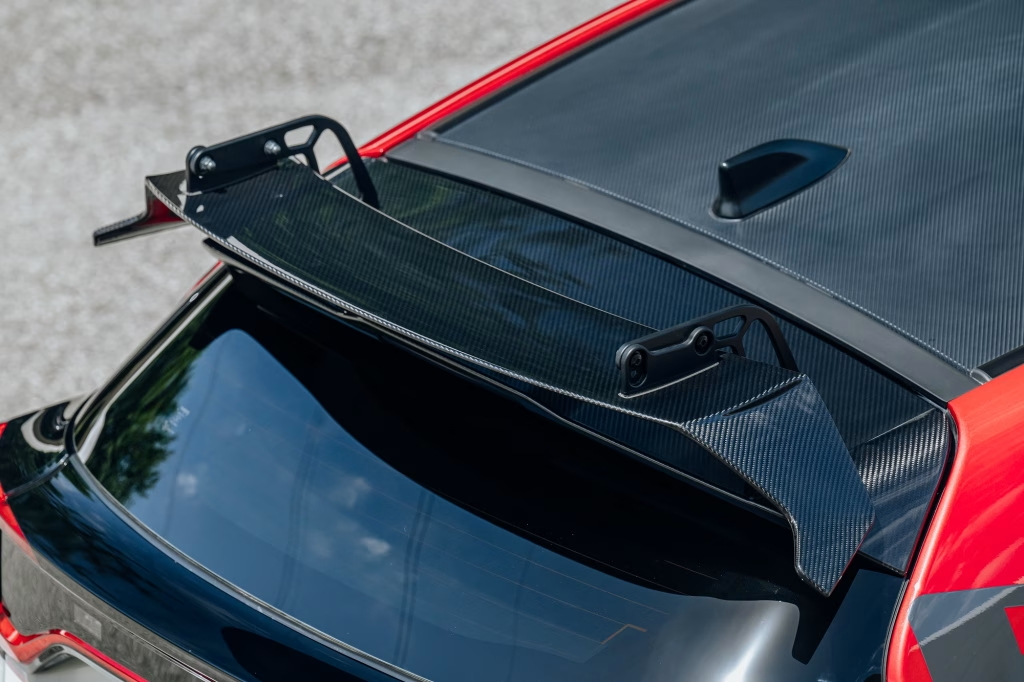
The bespoke GR Yaris chassis has been further strengthened and in the cabin the cockpit layout and driving position have been redrawn for a more authentic sports car feel, whether on-road driving or in motorsports competition. The suspension has also been adjusted for greater handling control and robust performance under high loads, with revised spring rates and a strengthened front shock absorber assembly.
The new GR Yaris offers everything that made the original such a success, but more so. As a result, it promises to set itself even further ahead of the competition.
A more focused range comprises a single version in “Circuit” specification that includes a cooling performance pack. This equips the car with an additional sub-radiator, intercooler spray and modified air intake.
The new GR Yaris will go on sale across Europe from Summer 2024.
GR YARIS: THE STORY SO FAR
- GR Yaris developed by TOYOTA GAZOO Racing
- Engineering and design benefit directly from TGR’s World Rally Championship-winning expertise
- More than 40,000 sold worldwide, with about half of these in Europe, since launch in 2020
The GR Yaris is the perfect demonstration of how Toyota and its performance arm TOYOTA GAZOO Racing are committed to developing ever-better cars through motorsport. From the outset, this was not going to be just another hot hatch: this was a car that in engineering and design terms directly reaped the benefits of TOYOTA GAZOO Racing’s championship winning experience in the WRC.
A new engine, a new electronic all-wheel drive system and a tailor-made chassis were all part of the plan. When the production car reached the hands of the press and customers, the response far surpassed Toyota’s expectations. Since the model’s 2020 launch, more than 20,000 cars have been sold in Europe, with a 99% customer satisfaction rating. Most of those sold have been the Circuit Pack version, hence the decision to focus on this specification for the new model. Customers include many performance car aficionados, who consider the GR Yaris to be worthy of a place alongside significantly more powerful prestige models in their collections. The GR Yaris is thus beyond categorisation; it is in a class of its own and an instant sports car classic.
The development programme that has delivered the new GR Yaris follows the concept of “develop, race, break, fix”. This describes how in seeking improvements, the car is pushed to its limits – literally to the breaking point of its components. Chief Engineer Naohiko Saito said: “Every aspect of the new GR Yaris incorporates the knowhow and expertise fed back from actual motorsport situations and from our Master Driver Akio Toyoda and race and rally drivers.”
POWERTRAIN: MORE POWER, MORE TORQUE, MORE CONTROL
- Maximum output from turbocharged three-cylinder engine increased to 280 DIN hp; maximum torque rises to 390 Nm
- Power unit “tested to breaking point” in race and rally competition to ensure durability
- Brand new eight-speed GAZOO Racing Direct Automatic Transmission
At launch, the GR Yaris’ turbocharged engine had the distinction of being the world’s most powerful three-cylinder production unit. Now it offers even more: power has been increased by 19 DIN hp and the driver can call on an additional 30 Nm of torque, with maximum figures rising from 261 DIN hp and 360 Nm to 280 DIN hp and 390 Nm.
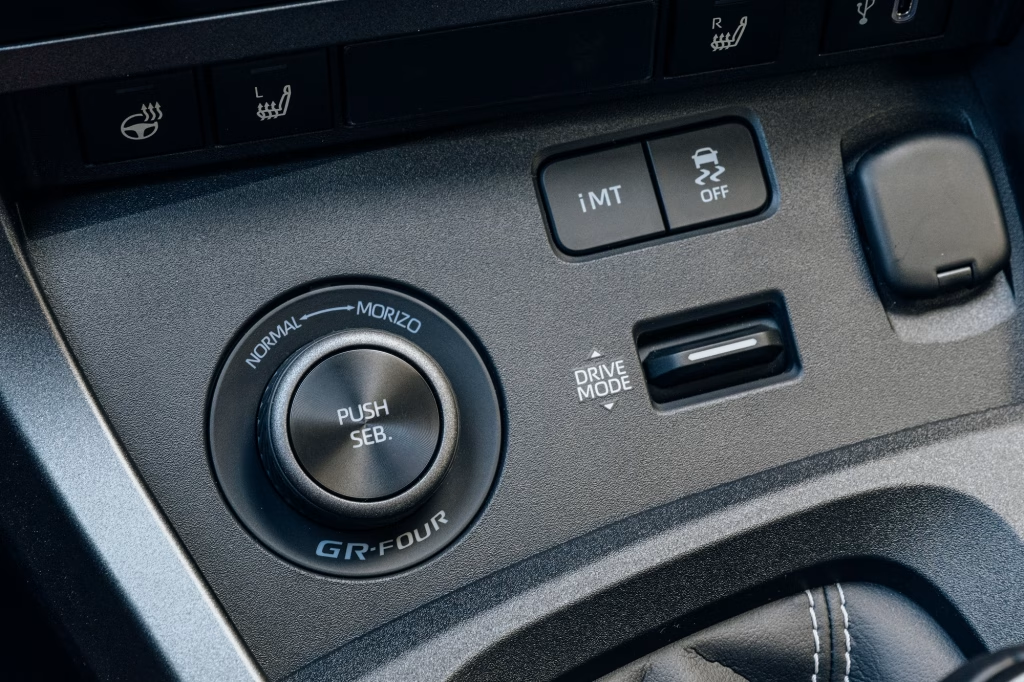
This new benchmark in performance reaffirms the car’s supremacy in its class, increasing its advantage over the competition and delivering an authentic race car feel that reaffirms how Toyota has realised its ambition to build a rally car for the road.
At the same time as engine output has been raised, steps have been taken to ensure durability is maintained. Once again, the race track and the rally stage were the proving ground, with the engine tested to breaking point in the Japan Rally Championship and the Japanese Endurance Race series. Details include a strengthened valvetrain, a new exhaust valve material and an increase in the D-4ST fuel injection pressure. New lightweight pistons with wear-resistant rings have been fitted and a new intake pressure sensor has been added.
The specification for Europe includes a cooling pack as standard, comprising an additional sub-radiator that extend the time the vehicle can be driven in full-throttle; modifications to the air intake; and an intercooler water spray.
A sporty engine sound is a key part of the GR driving experience. In the GR Yaris the effect is heightened by a control sound directed through the sound system’s amplifier to enhance the quality of the engine note. Active Noise Control uses a microphone to detect noise generated by engine rotation; cancelling noise is calculated by computer and output through the car’s audio speakers.
Fast shifting with new GAZOO Racing Direct Automatic Transmission
The introduction of a brand-new eight-speed GAZOO Racing Direct Automatic Transmission is one of the most significant changes in the new GR Yaris programme, offered as an option to the established six-speed manual gearbox. In designing the new unit, Toyota focused on achieving the fastest possible downshift speed. Using an automatic transmission also lets the driver focus more strongly on steering and use of the brake and throttle pedals.
Where conventional gear shifting relies on sensing vehicle behaviour, such as deceleration g-force and speed, the new transmission’s optimised software is also finely tuned to sense how the driver is using the brakes and accelerator. By doing so, it anticipates when gear shifting is necessary even before changes in vehicle behaviour occur, so that gear selection reflects the driver’s intentions and is similar to how professional drivers operate.
In track testing, the new system proved its value, helping secure faster lap times than the manual transmission. Handling performance is supported by the standard provision of front and rear Torsen limited-slip differentials.
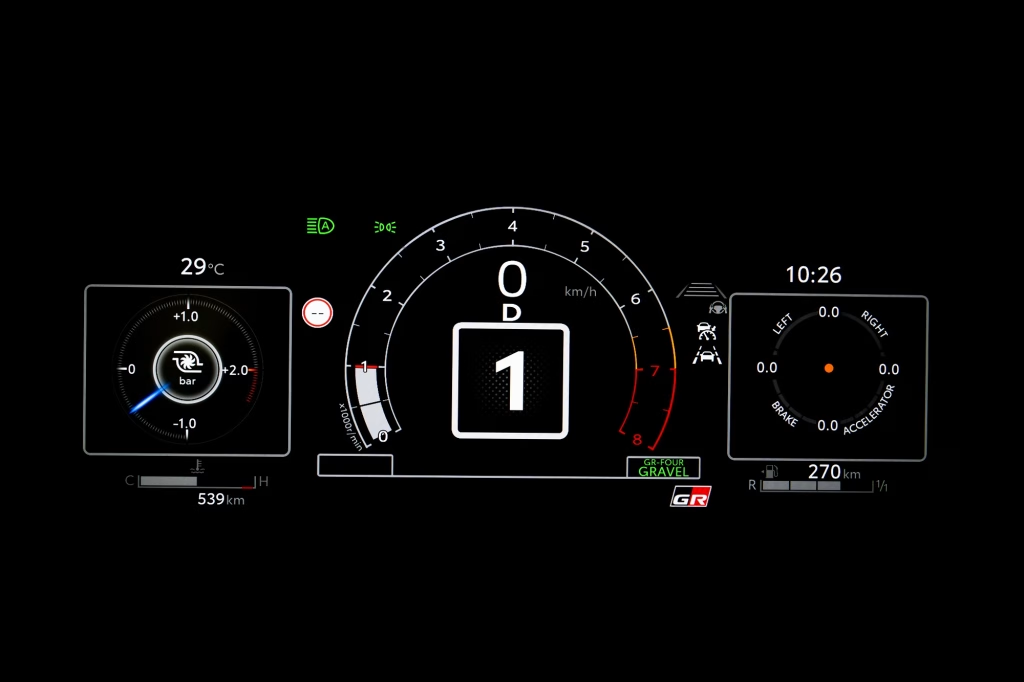
To address issues including the vulnerability of automatic systems to heat damage and the need to balance high shift speed with driveability, GR engineers carried out repeated materials and software revisions. The test programme included TGR World Rally Team drivers putting it through its paces on different surfaces, including snow-covered roads in Finland. The unit was also used in the Japan Rally Championship, the TOYOTA GAZOO Racing Rally Challenge and the Super Taikyu Series.
Increasing the number of gears from six to eight allows the transmission to have closer ratios. It also benefits from a new torque control system and a compact, high-response linear solenoid. Using highly heat-resistant material in the gear-shift clutch and adjustments tuning of the control software have produced world-class shifting speeds.
A new drive mode selection function is available to tailor the car for both sports driving and everyday use, with Sport, Normal and Eco modes engaging different settings for the electric power steering, air conditioning operation, throttle response and the driver’s instrument display. On models equipped with the GAZOO Racing Direct Automatic Transmission, the gearshift feel and selection are also adjusted. Shift feel is response-oriented in Sport mode and has a balance between shock and response in Normal and Eco modes. In Sport mode, response is prioritised in the D range, while using M range ensures the quickest shifting. The driver will find that working within the rev band from 4,900 rpm to the 7,200 rpm red line puts them at the heart of the action.
Six-speed manual sports transmission
Changes have been made to the six-speed manual sports transmission’s clutch system, adding a new dual mass flywheel so that the torque has been increased from 360 to 390Nm. The clutch characteristics have been tuned for controllable performance when making a rapid start and in competition driving.
Clutch pedal operation has been adjusted with the peak pressing force set relatively high to achieve the kind of feedback that’s appropriate for a sports car.
GR-FOUR ALL-WHEEL DRIVE
- GR-FOUR provides precise front/rear drive torque control
- Two limited-slip differentials manage left/right drive balance
- Driver can adjust AWD settings to suit conditions or their preference using mode switch
Optimum grip and traction are achieved with the GR-FOUR electronically controlled, permanent all-wheel drive system. The distribution of torque between the front and rear axles is governed by a high-response coupling, while two Torsen limited-slip differentials manage the split between the left and right-side wheels to give natural and direct car control.
The ingenious system uses slightly different gear ratios for the front and rear axles and allows for a theoretical range of front/rear torque balance from 100:0 (full front-wheel drive) to 0:100 (full rear-wheel drive). This flexibility gives a performance advantage over AWD on-demand systems that use twin-coupling or permanent AWD systems with a centre differential. The GR-FOUR system is also considerably lighter in weight.
The driver can adjust four-wheel drive performance to suit their preference or the driving situation using a 4WD mode dial switch. In normal mode the standard front/rear torque distribution is 60:40, but with new variable drive torque, the balance shifts in Track mode between 60:40 and 30:70. This increases the driving rewards on circuits and winding roads: the car will enter a bend with 60:40 distribution, but this will change to 30:70 to gain more rear wheel traction and secure better acceleration out of the bend. In Gravel mode the base setting is 53:47 for fast, competitive driving on circuits or special stages. In each mode, the torque balance will automatically adjust in response to the driver’s inputs, vehicle behaviour and road or track conditions.
The all-wheel drive system’s ECU provides linear control of the drive torque distribution, in line with the driving situation, responding to vehicle information including vehicle speed, acceleration and brake pressure. The system also uses an electronically controlled multi-plate clutch, operating according to data from sensors measuring wheel speed, G-forces and clutch temperature.
CHASSIS AND HANDLING
- Increased body rigidity delivers even better chassis and steering response
- Purpose-designed chassis combining elements of Toyota’s GA-B and GA-C platforms
- Suspension strengthened to enhance performance under high loads
The GR Yaris’ lightweight body has been rendered even more rigid with around a 13% increase in spot welds and the application of approximately 24% more structural adhesive. As a result, the car’s yaw response, steering feedback and grip feel have been enhanced, building what was already a taut and highly rewarding chassis.
The platform was purpose-designed for the car, combining the front section of the Yaris’ GA-B structure and a new rear end crafted from Toyota’s larger GA-C platform. The body shell is unchanged, with a roof made from a lightweight forged (rather than woven) carbon compound material. Aluminium is used for the bonnet and doors, again saving weight and helping lower the car’s centre of gravity. Thin-sheet steel is used in the wings and side members, with light and strong high-tensile steels in critical areas to ensure the car’s structure can safely absorb and dissipate impact forces.
Strengthened suspension
The light but rigid suspension systems have been retained – front MacPherson struts and rear double wishbones with trailing arms – but adjustments have been made in response to feedback from competition drivers. Adding extra bolts to fasten the front shock absorbers to the body suppresses changes in alignment that can happen when upper bush deforms in high-load driving. The front and rear springs have also been adjusted for optimum performance and improved handling control.
Brakes
The braking system comprises 356 mm ventilated front discs with four-pot, lightweight aluminium callipers and 297 mm ventilated rear discs with two-pot aluminium callipers. The callipers are painted red and decorated with the GR logo.
High-friction pads are used front and rear. The brakes’ heat capacity is suitable for circuit driving, with performance closer to that of heavier and more powerful C-segment cars.
The brake pedal has a short stroke and is tuned for solid feedback. Braking has a linear feel, with little variation between city and sports driving.
Steering
The steering is engineered for high control and linear feedback, contributing to how the driver feels a great sense of connection to the car, and to the road.
The additional bolts used to fasten the front shock absorbers contribute to sharper and more direct steering response. The driver receives the optimum feedback, even when making only small steering angle adjustments. Performance is further sharpened by minimising the delay before steering assistance is activated when the driver turns the wheel. The steering stroke ratio is 13.6:1 and the steering wheel takes 2.36 turns lock-to-lock.
Wheels and tyres
The new GR Yaris is fitted with 18-inch alloy wheels with a multi-spoke design, shod with Michelin Pilot 4S high-performance tyres, designed for extra grip for high-speed driving stability and control. 18-inch BBS forged alloy wheels are available in option.
COMPETITION-INSPIRED DRIVER’S COCKPIT
- Driver’s cockpit redesigned with input from professional race and rally drivers
- Key controls repositioned for quick, intuitive operation
- Driver’s field of vision increased
Significant changes have been made inside the GR Yaris to give the driver’s cockpit an authentically sporty feel with a design that’s true to the “driver first” principles that define the car.
The GR team took the inputs from racing and rally drivers as inspiration for re-positioning controls and giving the driver faster, clearer access. Race and rally drivers also had direct input into the changes.
Controls that often need to be used in competition driving, such as intercooler spray, VSC-OFF and hazard lights have been moved closer to the driver so they can be reached quickly and easily when using a racing harness. On the passenger side, the tray in the instrument panel has been made larger so there is space for extra meters or a co-driver’s monitor to be fitted.
The driver’s field of vision from the wheel has been improved by lowering the top edge of the instrument panel by 50 mm, changing the position of the rear-view mirror and angling the control panel 15 degrees further towards the driver.
The instrumentation includes a new 12.3-inch fully digital combimeter with two layout modes – normal and sport, the latter providing a sports performance-focused data display. The design is free of any superfluous ornamentation, so graphics are clear and information can be instantly viewed and understood. On the automatic model, the read-out includes transmission oil temperature and a visual warning in addition to a sound alarm to alert the driver when engine revs are too high for downshifting.
Precise changes have been made to give the driver the best posture. The seat has been lowered by 25 mm and steering wheel adjusted accordingly. The shift direction has been changed to suit competition driving so the driver pushes the lever forward for downshifts and pulls back for upshifts – a detail promoted by Master Driver and Toyota Motor Corporation Chairman Akio Toyoda (alias “Morizo”).
EXTERIOR DESIGN
- GR Yaris a model in its own right, sharing only three external elements with the standard Yaris – the headlamp, door mirrors and roof antenna
- New lower grille and enlarged side grille to enhance cooling performance
- Relocated rear fog and reversing lights
As might be expected in such a thoroughbred machine, the changes to the GR Yaris’ exterior are far from being simple cosmetic tweaks. Once again, the feedback from professional and master drivers and experience gained in the heat of motorsport have been integral to the revisions.
The essential package remains the same: GR Yaris is a three-door car that’s very much a model in its own right: only the headlamp, antenna and door mirrors are carried over from the standard hatchback. Every element has been revised to achieve optimum downforces, aerodynamics and grip.
At the front of the car there is a new steel mesh for the lower grille, optimised for the best balance of thickness, strength and weight reduction. The side grille has a larger opening and lower bumper has a new split-construction that makes it easier and less costly to repair or replace.
At the rear, an opening in the bottom edge of the lower garnish allows air from beneath the floor to escape, reducing drag, improving the car’s manoeuvrability and stability and dispersing heat from the exhaust system.
The fog and reversing lights have been relocated, moving from the lower bumper to be integrated in the rear combination lamps, reducing the risk of damage. Similarly, the high-mounted stop light as been moved from the rear spoiler to lower down on the back door so that all rear lamps are aligned and in a clear line of sight for following drivers. Moving the stop light also makes it easier for the spoiler to be changed or customised.
The new GR Yaris introduces a new exterior colour option, Precious Metal, in addition to the established signature shades – Emotional Red, Precious Black and Super White/Platinum White Pearlescent, representing the colours of the TOYOTA GAZOO Racing livery.
DEVELOPED IN THE SPIRITUAL HOME OF WORLD RALLYING
- Development centre at TOYOTA GAZOO Racing World Rally Team’s base in Jyväskylä, Finland
- Location allows for easy access to challenging roads for vehicle testing
- Model development faithful to TGR’s philosophy that “the road shapes the driver as well as the car”
When Toyota returned to the WRC in 2017 after 18 years away from rallying’s top level, an ambition to be the best was supported by the decision to base the new team in Finland. The town of Jyväskylä is widely regarded as the spiritual home of rallying and its location provides excellent access to challenging roads on which to test and tune vehicle performance.
This supports TOYOTA GAZOO Racing‘s belief that development is best achieved in extreme conditions and its philosophy that “the road shapes the driver as well as the car”. Around the world, people drive their cars in all conditions and on all types of surfaces, every day. To learn how to make ever-better cars, Toyota needs to gain a clear understanding of how ordinary people deal with their everyday driving demands.
Rallying is a motorsport that’s about how far cars can go in a wide range of driving conditions, which makes it the perfect high-level arena for gaining knowledge and experience and developing technologies, skills and solutions that can be applied to new production vehicles. This is why Toyota competes in the WRC.
OGIER AND ROVANPERÄ SPECIAL EDITIONS
- Two limited edition models celebrating World Rally Champions Sébastien Ogier and Kalle Rovanperä, aimed at performance car aficionados
- Each version features Gravel and Track all-wheel drive modes tuned to suit the driving preference of each champion driver
- Dedicated styling details including dedicated paintwork colours, liveries and carbon fibre rear spoiler
Two special edition versions of the new GR Yaris are adding an extra layer of appeal to the model range, developed with personal input from TOYOTA GAZOO Racing World Rally Team (TGR-WRT) champion drivers Sébastien Ogier and Kalle Rovanperä. Aimed at genuine driving aficionados, these highly exclusive cars were revealed for the first time at Rallye-Monte Carlo, the opening event in the 2024 FIA World Rally Championship (WRC), and will be built in very limited numbers.
The special editions are inspired by concept versions which were shown at the 2023 Tokyo Auto Salon, and have been created under the supervision of Ogier, who won two of his eight WRC driver’s titles with TGR-WRT, in 2020 and 2021, and Rovanperä, the winner in 2022 and 2023.
Their production reflects the desire of Master Driver Akio Toyoda – alias “Morizo” – to express his respect and gratitude to the drivers “who hone and grow our cars in rallies” and to the teams, the rally organisers and the sport’s fans.
In each car the “Gravel” and “Track” modes featured on the standard GR Yaris have been replaced with settings reprogrammed to reflect each driver’s personal preferences for handling and performance. The “special edition” quality also includes distinctive new exterior and interior styling features.
Both cars are powered by the latest development of the GR Yaris’ 1.6-litre turbocharged three-cylinder engine, producing 280 DIN hp and 390 Nm of torque, matched to six-speed intelligent manual transmission (6iMT),
Ogier Edition
The Ogier Edition GR Yaris has two new AWD control modes: Morizo and Seb. The Morizo mode has been developed by Morizo (Akio Toyoda) through his rally driving experiences. It is calibrated to help deliver consistent race times under acceleration, partial acceleration and braking.
The Seb mode, developed by Ogier, uses 40:60 ratio of front and rear torque distribution. All-wheel drive distributes more torque to the rear axle, so that rear tires produce pushing force more.
This gives the driver a sense of being fully connected with the car and will help them achieve quicker times with high-speed driving body control.
The Ogier Edition’s bodywork has a dedicated Matt Stealth Grey paint finish and features the French national flag (Ogier’s home nation) on the radiator grille and the 18x8J BBS forged alloy wheels. WRC commemorative stickers are added to the front wings.
The stand-out details also include a new-design carbon fibre CFRP rear spoiler and blue-painted brake callipers. TOYOTA GAZOO Racing decals have been added to the left and right doors and an Ogier Edition logo to the back door.
Inside, there is a WRC victory commemoration plaque on passenger side of the instrument panel and contrast blue, grey and red stitching (honouring the French national colours) on the steering wheel. Grey stitching is used for the shift and parking brake gaiters and the seat upholstery.
On both special editions, the new GR Yaris’ digital instrumentation has been revised to include the new modes, together with the regular Normal AWD control mode.
Rovanperä Edition
The Ravonperä Edition has a unique Donut Mode, created specifically for the WRC’s youngest champion who is highly skilled in drifting and performing tyre-smoking donuts. Thanks to the constant-velocity rear differential gear, front and rear axles will rotate at the same speed. Allowing constant maximum torque to the rear, perfect for “door turns”.
This GR Yaris version also provides a Kalle Mode. This uses 40:60 ratio of front and rear torque distribution, which is the same as Ogier mode, but due to the constant-velocity rear differential gear, the rear torque remains unchanged unlike the Ogier version ensuring nice stable drifting slides.
The car has an exclusive three-tone paint finish, applied as a series of painted motifs by the designer of Rovanperä’s drift car livery, Henri Liupakka. WRC victory stickers are added to the front wings and there are TOYOTA GAZOO Racing decals on the doors and rear bumper and a Rovanperä Edition badge on the back door. As well as BBS 18x8J forged alloys, the car is fitted with a CFRP variable wing rear spoiler, shared with the GRMN Yaris, and constant-velocity rear differential gears, engineered to perform under sustained high drive loads.
In the cabin the trim and upholstery stitching again match the driver’s national colours, in this case blue and grey for Finland. As in the Ogier Edition, a special plaque commemorates TGR’s WRC victory.
Summary of Special Edition features
| Ogier Edition | Rovanperä Edition | |
| Exterior | Matt Stealth Grey paintwork | Exclusive three-tone paintwork |
| WRC victory stickers on front wings | WRC victory stickers on front wings | |
| French national flag decoration on front grille | 18x8J BBS alloy wheels | |
| Blue-painted brake callipers | TOYOTA GAZOO Racing logo on wheels | |
| 18x8J BBS forged alloy wheels | TOYOTA GAZOO Racing decals on front doors and rear bumper | |
| French flag and TOYOTA GAZOO Racing logo on wheels | Rovanperä Edition badge on back door | |
| TOYOTA GAZOO Racing decals on front doors | Variable wing CFRP rear spoiler | |
| Ogier Edition badge on back door | ||
| New-design CFRP rear spoiler | ||
| Interior | WRC victory commemorative plaque on instrument panel | WRC victory commemorative plaque on instrument panel |
| GR fully digital instrument display, including new Morizo and Seb drive modes | GR fully digital instrument display, including new Donut and Kalle drive modes | |
| Steering wheel stitching – French national colours (red/grey/blue) | Steering wheel stitching – Finnish national colours (blue/grey) | |
| Grey stitching for seat upholstery, and shift and parking brake gaiters | Blue and grey stitching for seat upholstery, and shift and parking brake gaiters | |
| Mechanical | All-wheel drive modes: Morizo, Seb and Normal | All-wheel drive modes: Donut, Kalle and Normal |
| 1.6-litre turbocharged 3-cylinder engine with 280 DIN hp and 390 Nm | 1.6-litre turbocharged 3-cylinder engine with 280 DIN hp and 390 Nm | |
| 6-speed intelligent manual transmission | 6-speed intelligent manual transmission | |
| Constant-velocity rear differential gears |
SAFETY AND EQUIPMENT FEATURES
- Third generation Toyota Safety Sense as standard
- Toyota Smart Connect + multimedia system with wireless smartphone integration
- Fully digital driver’s combimeter
Third generation Toyota Safety Sense
Notwithstanding its pure-bred performance profile, the new GR Yaris is equipped as standard with the latest, third generation of Toyota Safety Sense, providing a comprehensive package of systems to detect potential hazards, provide timely warnings and, when needed, provide steering, braking and drive assistance to help avoid a collision.
Should an impact be unavoidable, the car’s body structure is engineered to deform, absorbing and dissipating impact forces in a controlled fashion and safeguarding the integrity of the passenger cell.
The safety and driver assistance systems have been updated for added functionality and enhanced performance. For example, the Pre-Collision System can now recognise motorcycles and oncoming traffic and its intersection collision avoidance support can detect crossing vehicles. The Dynamic Radar Cruise Control has gained added turn-signal linked control and deceleration assist and it offers a wider choice of distance settings. Future software updates for the car’s safety and multimedia systems can be delivered over the air via the Data Communication Module (DCM), avoiding the need for the car to be taken to a service centre.
Equipment specification
New equipment features* include the Toyota Smart Connect + multimedia system with eight-inch touchscreen, navigation (both cloud-based and embedded systems), wireless smartphone integration with Apple CarPlay and Android Auto a 12.3-inch digital driver’s combimeter.
Exterior features include power-folding heated door mirrors, rear privacy glass and automatic headlights. In the cabin there is dual-zone automatic air conditioning, front sprots seats, aluminium pedals and GR steering wheel. An app-based digital key, giving up to five users the convenience of accessing and starting the car with their smartphone, will be made available for the new GR Yaris during 2024.
EXPLORING FUTURE POSSIBILITIES: THE HYDROGEN-FUELLED GR YARIS
- The GR Yaris’ turbocharged three-cylinder engine has been converted to run on hydrogen
- Engineering study uses elements from the Toyota Mirai hydrogen fuel cell electric sedan, including hydrogen tanks installed in the GR Yaris’ boot
- Demonstration of how existing internal combustion engines can be adapted to use carbon-neutral hydrogen
Toyota includes the development of internal combustion engines that can run on carbon-neutral fuel in its multi-path technology approach to reducing and ultimately eliminating vehicle CO2 emissions. Its development programme has already produced high-performance hydrogen powertrains for race cars competing in enduring events in Japan.
It has further investigated the potential of hydrogen ICE engines by converting the turbocharged three-cylinder gasoline engine that powers the new GR Yaris. Thanks to technologies developed by Toyota and TOYOTA GAZOO Racing, the conversion process is relatively straightforward: the major changes are replacement of the fuel tank and related fuel lines with components suitable for hydrogen.
Many parts have been adopted from the Mirai, Toyota’s hydrogen fuel cell electric sedan, including high-pressure fuel tanks, installed in the GR Yaris’ boot. The principal change to the engine itself is the installation of a new fuel system with injectors, piping and spark plugs.




